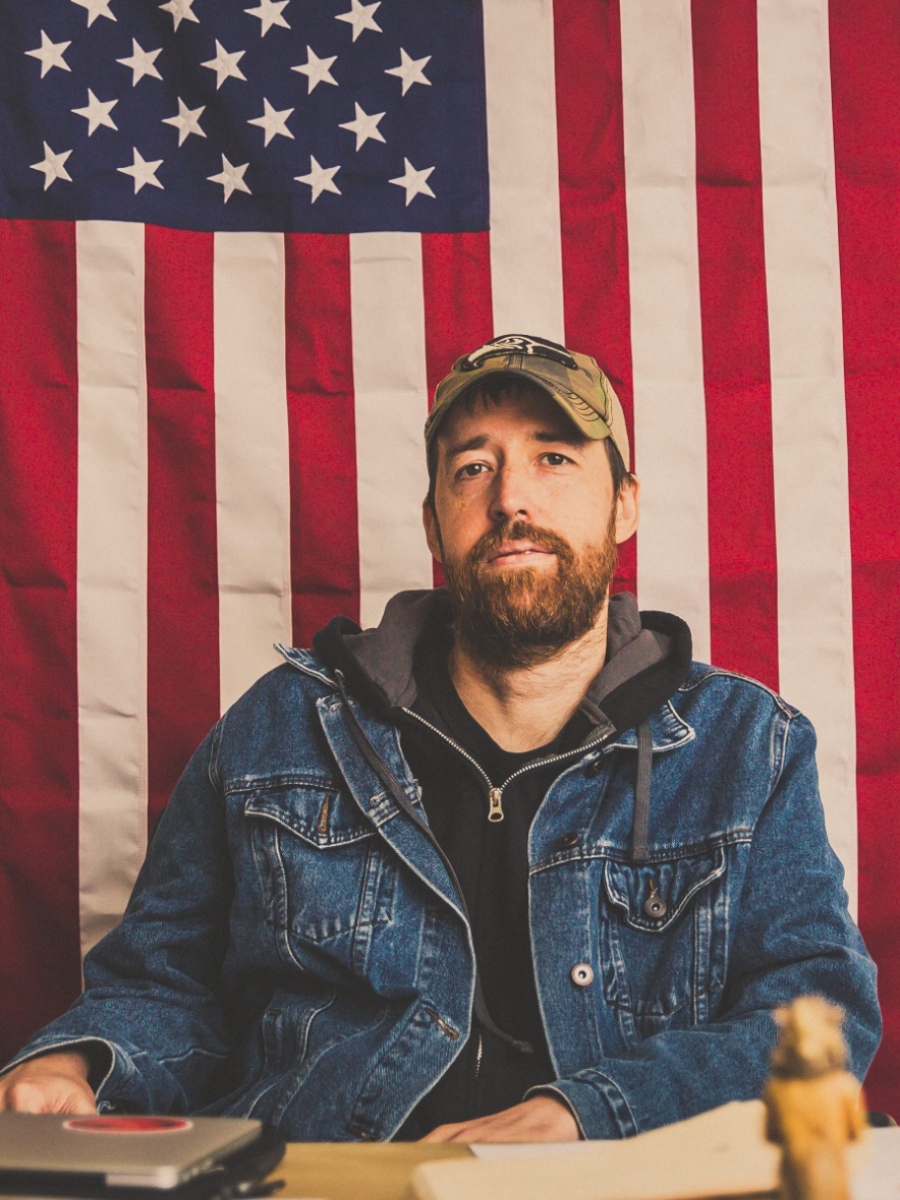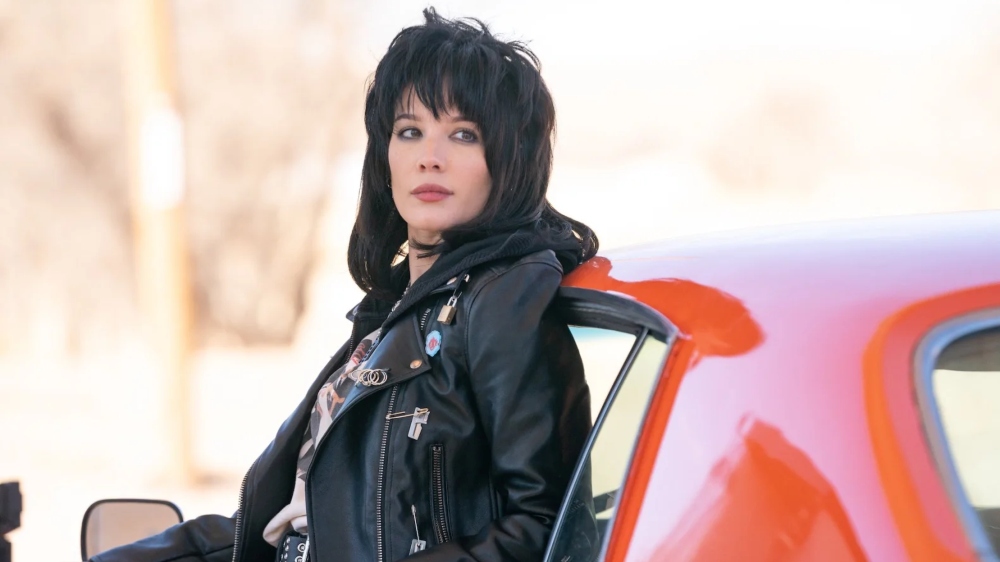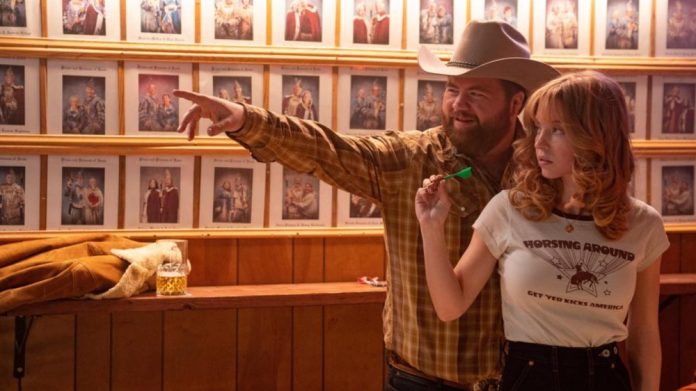TV writer and producer Tony Tost has been working in the entertainment industry for more than a decade on shows such as Longmire, Damnation, and The Terror, though he stepped behind the camera for his feature directorial debut Americana, a wild story of interesting criminals and personalities in South Dakota.
Among the indie film’s many characters are a young boy named Cal (Gavin Maddox Bergman) who thinks he’s a reincarnated Native American; his protective mother, Mandy (Halsey), and an opportunistic veteran, Lefty Ledbetter (Paul Walter Hauser), who teams up with a small-town waitress, Penny Jo (Sydney Sweeney), for a big score. Other players with their own nefarious motives include Dillon (Eric Dane), Roy Lee Dean (Simon Rex), and Ghost Eye (Zahn McClarnon).
Tost’s script weaves together multiple overlapping storylines to create what he calls a modern-day Western, heavily influenced by the films he grew up watching but also calibrated to the sentiments of today’s social climate. He emphasizes that he wasn’t trying to make a political statement with Americana but instead hoped to explore themes inspired by his own experiences of growing up in proximity to Native American communities.
Above the Line spoke with Tost just after Americana made its world premiere at SXSW, and he explained how he constructed the film while stressing the need to honor his own heritage and formative experiences as a child.

Above the Line: This film is inspired by your own life and yet nothing in it actually happened to you. Can you explain that?
Tony Tost: Yeah! Where to begin? I have this big-time blue-collar chip on my shoulder. I’m a small-town guy. Grew up in single and double-wide trailer parks. Raised on old Westerns, Burt Reynolds and Clint Eastwood movies, pro wrestling, [and] country music. That’s my cultural heritage. Nobody in my family went to college. There weren’t books in the house or anything like that. It wasn’t really until I finished high school that I even realized I was creative. It just didn’t cross my mind that I liked art or literature. I hadn’t really accessed it.
It’s autobiographical in a couple different ways. One is just simply that’s the stuff I was raised on. I love it. It’s only looked down on, I think, if it ever makes an appearance in mainstream storytelling. I’m trying to pull some of that iconography, archetypes, the vibes of the stuff that I love [and] that I was raised on, [and] pull it into 2023, warts and all. Not an act of pure nostalgia, but to try to look at it through fresh eyes. I know that there are problematic elements of the old Westerns in terms of who is centered in the stories. I know that there are all these warts in there. There’s a little bit of a revisionist element in there but there’s also just a real love of that kind of storytelling.
Also, I feel like I was raised by pop culture. I connected with that stuff more than, say, with my family. I grew up isolated. To talk about my childhood without bringing in watching Westerns all the time or [them] living in my head would not be really talking about my childhood. [So] there’s that. Cal, the kid, is not strictly based on me, but there’s a lot of me in there. The dynamic in the trailer and his weirdness — watching Westerns all the time. Even the trailer looks like one of the trailers that I grew up in, and how isolated it is. The fraught dynamic with Mandy and Dylan and all that.
If Cal is an exaggerated version of childhood me, Penny Jo, in a lot of ways, is the young artist me. Being in a small town and thinking that I have a calling and a gift but no idea how to get there. I’m miserable here. A whole bunch of people didn’t die for me to go chase my dreams, but I’m the only person in my family that doesn’t live in the same county in the Ozarks up to second cousins. Everybody lives there. I had to venture out on my own, [and] leave home and leave my family to chase this thing that I was never quite sure was going to work out.
[So] there are elements of that. I could do versions of that for lots of the characters. With Lefty, I’m not a very cynical guy, and there’s a certain kind of earnestness and simplicity with him that I recognize as similar to my own. It’s not like, this event happened, this event happened [and that] event happened. It’s more, like with a lot of writers, there are pieces of me in there. There are pieces of my childhood, people I knew growing up, [and] places I remember growing up that fuse with the stories I grew up watching. It’s almost like trying to fuse the pop culture and the biographical thing to try to find something that’s maybe a little specific or unique to that story.
ATL: There are so many different characters and so many versions of yourself. Was this always just one movie at the start?
Tost: It was. It’s funny, the opening section with Cal and Dillon, I had a version of [it] in my head for a year before I sat down to write anything. I didn’t know what to do with it, but there was something there. I actually wrote it down first as a series of images, of shots. Some of those made the final version of the film and some didn’t. Then, I thought I would do an anthology film, like Damián Szifron‘s Wild Tales or [Jim] Jarmusch‘s Night on Earth, [with] thematic links. I started writing that with these different characters and different stories. Pretty soon, I’m like, ‘oh! I can connect these. These are all related.’ They were all in there, but my original concept was that they would be separate, and then, almost halfway through, I realized, ‘no, I think I want to connect these all together. It will be a more interesting viewing experience and story.’ The nucleus was always that opening Cal thing and trying to create a world and a story where that somehow made sense.

ATL: Speaking of Cal, he’s this white kid who thinks he’s a reincarnated Native American. Were you at all nervous about the optics of that these days?
Tost: I was less nervous than everybody else. Like Ghost Eye says, ‘we’re not in the golden age of cultural appropriation now.’ It’s a touchy thing, especially for people in Hollywood. They do not want to be seen as being on the wrong side of history, or the wrong side of culture wars. Because I’m so interested in the legacy of the Western [and] the idea of a white kid living in a trailer with a modern-day cowboy. The opening shot is my trailer-trash version of a John Ford doorway shot of Dillon shooting bottles. In the world he’s growing up in, that’s the cowboy. Watching all these Westerns, he doesn’t identify with the cowboys. He identifies with those trying to kill the cowboys, even if he doesn’t realize it — that’s my thinking. That’s my justification for it. But he’s too innocent. He doesn’t understand the problematics of this.
For me, he’s just trying to survive a situation. He’s almost pretending to be somebody else, but then events play out so he actually has to leave this world of old Hollywood Westerns and how they present Native Americans, or Indians — Zahn McClarnon makes fun of me when I say Native Americans. We’re Indians! Say Indians! He leaves the world of the TV version and goes into our real-world version on the res of modern American Indians, and they don’t match that Hollywood version at all. They’re listening to hip-hop, and they’re into movies. They’re reading other stuff. They’re not just symbols of whatever. That was an interesting way of trying to update [things], without being preachy, using humor. Cal is carrying this Hollywood tradition of how American Indians are presented on the screen, and then he has to meet a 2023 different alternative to it. Can he cope with it?
Part of it is also trying to get both him and Mandy to a point where, by the end, hopefully, they’re dropping a bit of their protective armor. He’s not trying to appropriate. He doesn’t understand that. He’s just trying to protect himself by pretending he’s someone else, and that’s just something he latches onto. I’m not trying to write a thesis statement on cultural appropriation, but I’m edging into that. Some people will feel that it goes too far or that it’s inappropriate. Everybody gets to have their reaction to it. I’m trying to use that to tell a character-based story, something about this kid and Ghost Eye and the humor of Zahn dealing with a kid doing that. I always thought that would be funny because Zahn is so funny.
I get tired of editorializing, and this anxious op-ed concept of anything sensitive. I was trying to use humor, and the idea of somebody watching and being like, “oh, where is this movie going to go with this?” That’s appealing to me. It’s a little scary, but we’ll see. It’s also just a movie. I think people are going to be okay either way. They’ll have a good time or they won’t. I hope everybody, no matter what their background, feels invited to the movie. I don’t feel like we’re making fun of anything other than this kid’s innocent, oblivious idolatry and not understanding it. I don’t think we’re making fun of Lakota culture or anything like that. People might disagree, which is also fine.
ATL: You’ve worked with Zahn before on Longmire. This film is certainly much darker, but was that series formative in the genesis of this film and how you wanted it to be?
Tost: Totally. I loved working on Longmire. I’m a white dude. I did grow up next to the Muckleshoot Indian reservation. I’m not of that world but I’m adjacent to that world. It’s a long way of saying, on Longmire, I would often be given, or I would often pitch stories set on our fictionalized version of the Cheyenne reservation, just because of the intersection there between reservation life and the predominantly white adjacent life. I grew up close to that border space and I find it very interesting for storytelling. Especially with my love of the Western. I don’t want to dismiss Longmire, but I wrote a lot of stories with victims on the res. It’s a place where that happens, but I had written those stories of suffering and I wanted to write something for Zahn where he’s not a victim. He’s a cool guy with this subversive, almost countercultural group, and it’s not expected. We could find some different shadings than we did with Officer Mathias on Longmire.
We would film all over New Mexico, and I just noticed that, if we filmed on a reservation, a lot of younger Native youths had hip-hop shirts and heavy metal shirts. What you might call “urban” attire. Seeing that and noticing that, I thought there was something interesting between how this life on reservations and in Native cultures is represented in movies and what I’m actually seeing on the ground and in the present day. That juxtaposition always stuck with me. You’re always looking for unexpected turns or weird juxtapositions and upending expectations in that way. It just arrived organically. All these little experiences feed into that.

ATL: This film has a great cast of rising stars, especially for an indie. Was there anyone you were particularly determined to go after or surprised to get?
Tost: Everyone. I don’t want to identify someone and overlook someone [else]. Everyone felt like a huge get to me, especially for a first-time filmmaker. To get Sydney right when her star is really rising and to have a role where she can show a different shade of her talent was amazing. To have a gut instinct about Halsey. We reached out to Halsey when I saw a music video of hers and I was like, ‘I think this is Mandy.’ I sent her the script and she dug it. We talked and it really paid off. She gives one of the best performances and is getting some of the best reviews in the film for [her] performance, [and] rightly so.
I was very confident in Paul Walter Hauser because I think he’s been one of the most consistently great character actors we’ve got going now. This is an ensemble, so there’s no official lead, but if there is, it’s him. Pairing him with Sydney Sweeney is not something you would often think of as a couple, but to me, there’s an authentic sweetness and connection between them. That maybe was out-of-the-box thinking, but I’m very happy with it.
You don’t often picture Simon Rex with a cowboy hat. He adds this whole new energy to Roy Lee Dean, [which] I think adds to the enjoyment of the film. I think the last main role that we cast was Eric Dane as Dillon. I was just infatuated with Eric’s performance on set. He joked to me, ‘I’m not happy until I’m almost doing nothing.’ He so understands that he doesn’t have to do very much to hold the frame, and there’s this calm stillness to him.
There’s a great juxtaposition [between] what Halsey is doing with Mandy and what Simon Rex is doing with Roy Lee Dean that adds this whole new flavor. Dane also made Dillon funnier on screen than he was on the page. These little rolls of the dice — and they’re rolling the dice on me — feel like they’re paying off. [They] give this specific energy to the film that more conventional casting wouldn’t have brought. That’s one of [its] more satisfying elements.
ATL: Did you have any surprising takeaways as a first-time feature director?
Tost: I’ve been working in TV for a little over a decade before this. Almost everything that I did as a director, I had to do some form of as a writer, producer, or showrunner. I think the biggest surprise was how nice everyone was with me as a first-time director, and how supportive they were. You hear about losing the crew or losing the cast. I’m not a big personality. I’m a pretty quiet, chill guy. I’m not barking orders or anything like that. That can either be reassuring or it can be like, “wait, this guy’s kind of an introverted, quiet dude.” You could call it a leadership style, but I’m just trying to connect people together and get everyone on the same page. I’m not trying to lead people into battle. I don’t give big speeches. We had a great cast and crew that worked well with that directing style. I was really anxious about that and ultimately really happy with how that worked out.
Americana had its world premiere at the SXSW Film Festival.



